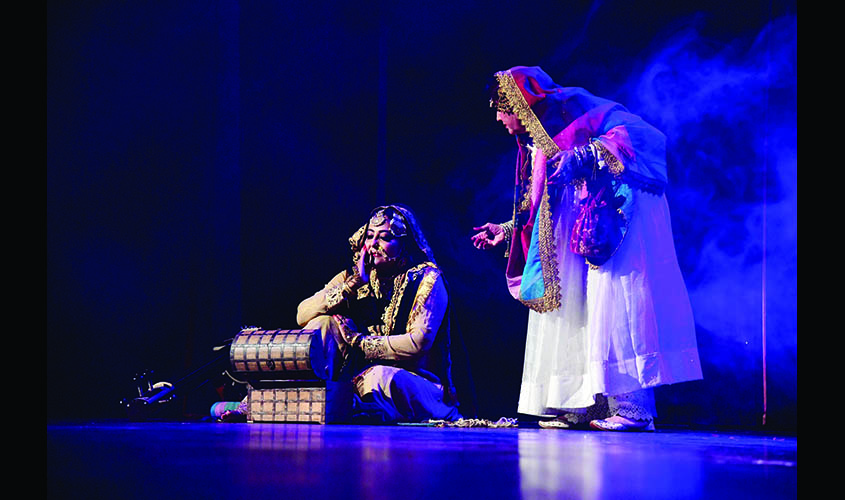The courtesan culture of 19th-century Awadh is the subject of a recently performed musical drama at Delhi’s India Habitat Centre. The show takes us back to an age when the term tawaif was associated with high culture, writes Rishita Roy Chowdhury.
Certain forgotten chapters of history are often best brought to life through art. On 25 September, the dance troupe, Gandharvi, presented one such moth-eaten chapter about the courtesans Lucknow through dance and drama at the India Habitat Centre, New Delhi.
Titled Gulabi Jaan, the performance wasn’t so much centred on a story that has been lost in the sands of time, as on a story that has been deliberately suppressed. This was the story of the courtesans of Awadh—their glorious days as tawaifs in the early 19th century, to their fall from grace during the expansion of British rule in India.
The semantics of the word tawaif are interesting to observe—how the term was over time rid of its original meaning (which was closer in significance to the term artist), and soon devolved to the more degrading, bais or prostitutes. Similarly, their contribution to the Mutiny of 1857 isn’t common knowledge anymore. With this performance, Gandharvi wanted to change this and open society’s eyes to our once-dignified courtesan culture.
Shukla Banerjee, the director of the play, has been fascinated by history. The hush-hush conversations about tawaifs always irked her. She said, “I always had this desire to do something for the courtesans of history. Despite being a Bengali and growing up in Kolkata, I learnt Urdu and read extensively about tawaifs. I formed this troupe seven years ago with like-minded people. Gulabi Jaan is our attempt to turn back the clock to that era. The relevance and contribution of courtesans should not be forgotten. So today, we ruffle through those dusty pages of history.”

The story has been told through Gulabi Jaan’s eyes—the famous courtesan who was known for her exquisite beauty, singing and dancing skills in 19th-century Lucknow. This role was performed by the renowned ghazal singer Pamela Singh.
When the act starts, we see an aged Gulabi Jaan sitting in a dimly lit corner of her house, looking at herself in a mirror, putting lipstick and stroking her cheeks. She sits there reminiscing of her youth, recollecting memories of a time when she was valued. After fixing her makeup and attire, she gets up and sings the song, “Abhi Toh Mai Jawaan Hu”, her expressions conveying a mix of high spirits and sadness.
The other characters in the drama were Anjuman Bano (played by Manju Tripathi, who narrates the story), Munira Bai, Shakila, Firdaus and Azizan Bai. Through their acts and dance sequences, the performers depicted how tawaifs lost their artistic and aesthetic magnificence, and were reduced to the role of concubines. In this tribute, courtesans were shown as respectable, courteous and courageous women.
Remembering courtesans like Gulabi Jaan, the narrator said that back in those days, celebration and mujra was done all night and the courtesans never got to know when the morning came. Before the onset of British rule in India, courtesans enjoyed high status in our society, but most of all, they had respect. They got education, owned properties and held musical and dance assemblies. They were not regarded as women of questionable character. In fact, young boys from affluent families were sent to them to learn courtesy, demeanour and etiquettes.
The courtesans were also brave and independent. During the Revolt of 1857, they gave shelter to rebel soldiers, hid the weapons and ammunitions and helped provide medical aid to injured fighters. Many courtesans were martyred on the battleground where they fought with valour and others were executed. All this while, they found peace in singing and dancing.
In the aftermath of the Mutiny, they had to leave Lucknow and move to Kolkata along with Nawab Wajid Ali Shah. The helplessness caused their profession to decline. Several were forced into the business of flesh trade. They lost their status and social importance; all they had was their art, and even that faded away.
The chief guest at the Delhi event was Dr Chinna Dua, a well-known radiologist who works for women’s empowerment. She said, “The performances were very good. It’s important that people know about this history because many from the younger generations are not aware of the courtesan culture. They think a tawaif is someone with loose character and morals… Actually, these women were well-versed with poetry, music and dance. That should be highlighted and remembered.”
Gulabi Jaan beautifully recreates those mehfils Lucknow was once known for. There were kathak, dadra, ghazal and thumri performances on the stage. It wasn’t just about a tawaif as a performer, but also about their emotions, their struggles and their identity. Tawaif was not a term of derision during the golden age of Lucknow, which many historians say was the golden age of culture as well.
Classics ghazals like “Hazaron Khwaishe Aisi”, “Aaj Jaane Ki Zid Na Karo” were also performed at the Delhi show. This was to showcase the love story of Mirza Ghalib and Munirabai. The play ended with Gulabi Jaan performing a song in Bengali, remembering her heyday. The indomitable spirit of art brought recognition to the lost and forgotten courtesans of Awadh. Gulaabi Jaan aims to revive that lost memory.

